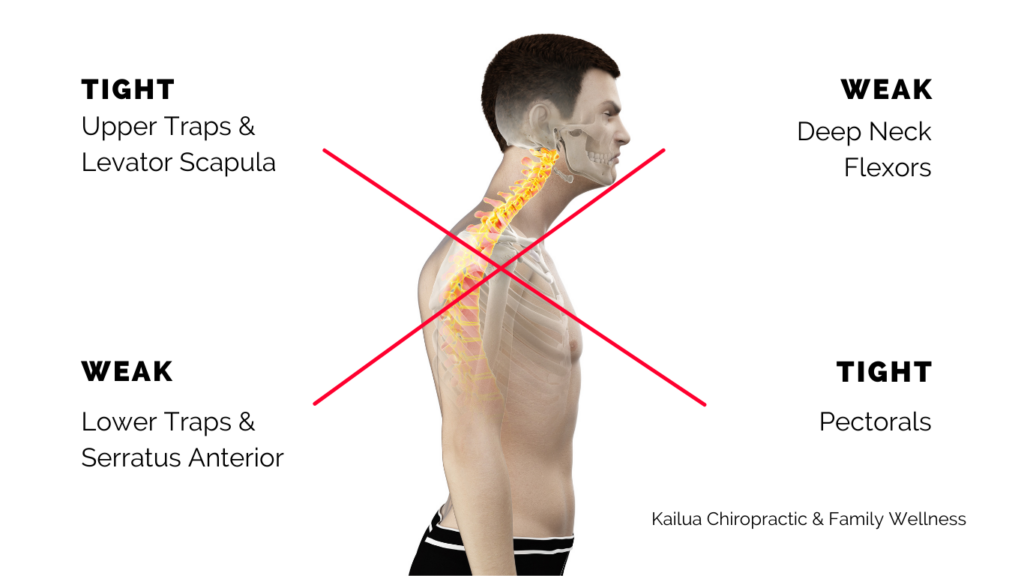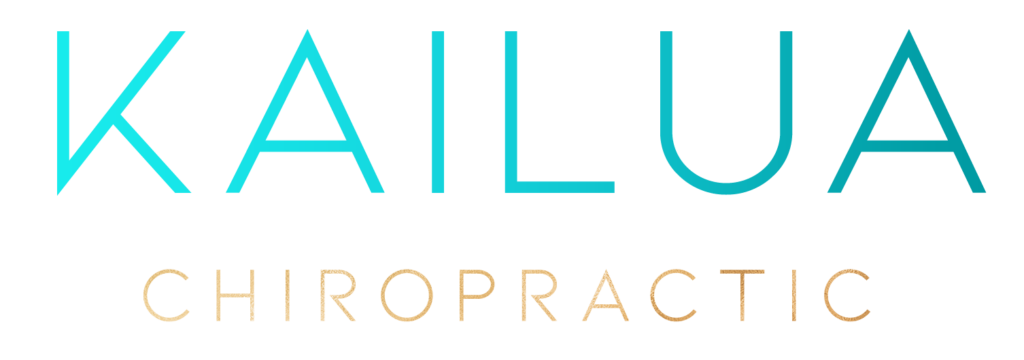Even if you’re unfamiliar with the term “upper cross syndrome,” also known as “Forward Head Posture,” you’ve likely seen it or heard someone complaining about its adverse effects. The condition is more prevalent in the modern era due to technological advancements changing our daily lifestyle habits. Fortunately, with proper guidance and preventive care, one can easily understand and reverse its detrimental effects. Here at Kailua Chiropractic Family Wellness, Dr. Cara commonly works with upper cross syndrome and is available to help you correct it.
What is Upper Cross Syndrome?
Upper cross syndrome occurs when bilateral neck, shoulder, and chest muscles lack balance, strength, synergy, or function due to poor posture over an extended period of time. Chiropractors understand how the body’s structural “form follows function.” Consequently, how
we position our head and neck daily creates postural changes over time which decrease function. The syndrome is progressive and usually starts with excessive tightening of the pectoral, upper trapezius, and levator scapula muscles. As they become strained and overused, weakness develops in the serratus anterior, rhomboid, lower trapezius, and deep neck flexors.
The muscle imbalance in upper cross syndrome is self-reinforcing – overused muscles become tighter and shorter as the body recruits them more readily while underused muscles become weaker due to lack of recruitment. A postural assessment helps determine if an X shape is forming between the front and back of the upper body as the muscles grow tighter and weaker hence the name “Upper Cross Syndrome.” If left unresolved, the muscle imbalance leads to restricted, uncoordinated movements in the joints of the neck, shoulders, and upper back.

Signs and Symptoms
You’ve likely seen this condition because you probably know someone in your own household who is suffering from it. Use of electronics has become a favorite pastime in addition to the demands required during school or in the workplace and it is increasingly common to see someone craning their neck forward with their shoulders scrunched up towards their ears (and rounded forward) while on a device. As the heavy head moves forward, the supporting muscles in the neck, upper back, and shoulders tighten and adapt further, placing excess strain on surrounding fascia, tendons, ligaments, and bones. In the advanced stages of the condition,
more serious complications may appear including:
- Degenerative changes in the spine
- Shoulder dysfunction
- Chronic neck pain
- Tension headaches
- Migraines
- Fatigue
- Chronic inflammatory response
- Jaw pain
- Low back pain
- Decreased ROM
- Numbness and tingling in the arms, chest, and rib cage
Causes and Prevention
Upper cross syndrome may result from an athletic or a non-athletic lifestyle. Of course, one of the greatest drivers in developing UCS is the stereotypical sedentary lifestyle. Ergonomics at work or at home play a big part in the increased risk of developing the muskulo-skeletal disorder which affects the nerves, blood vessels, ligaments, and tendons. For example, a 2019 study finds teachers at a higher risk of developing the syndrome. Prolonged driving or continuous use of the computer screen, television, or cell phone may increase risk. Performing manual labor in a flexed or hunched forward position increases risk. Even active people such as long distance road cyclists are susceptible to developing the condition due to prolonged periods of hunching forward while riding their bikes. Ultimately, upper cross syndrome is always the result of poor posture.
In addition to correcting upper cross syndrome in the office with gentle, specific adjustments to the spine, Dr. Cara also gives practical tips to help you prevent its persistent progression at home. Proper self-care can be empowering and reinforce the benefits of chiropractic care between visits. Some of her favorite exercises include:
- Gentle chin tucks – Sit up tall with your neck relaxed and your head neutral. While looking forward, pull your chin backwards gently without tilting your head downward (retract chin). Hold this position for 8-10 deep, relaxing breaths then rest for 8-10 breaths. Repeat five times. You can do this when stopped in the car or at home 3-4 times daily. This exercise helps strengthen the muscles that naturally align your head over your shoulders and can relieve pain while improving posture.
- Trapezius stretch – Sit up tall and slowly move your left ear towards your left shoulder. Rest your left hand gently on the right side of your head above the ear. Continuously breathe and hold for 30 – 60 seconds. Then release and repeat on your right side. Repeat this stretch 3-4 times daily. It will help relieve tension and prevent your trapezius muscles from involuntarily scrunching upwards.
- Shoulder blade squeeze (rhomboids) – Sit up tall with your spine neutral and your arms relaxed along your sides. Pull your shoulders backwards and a little downwards. Breathe and hold for 8-10 seconds, actively squeezing your shoulder blades together. Repeat five times per set and perform 2-3 sets daily. This opens your heart and improves shoulder function.
- Brugger’s Relief – Sit up tall on the edge of your chair with your feet slightly apart. Open your arms down along your sides slightly wider than your shoulders with your palms facing forward. Tilt your pelvis forward, lifting and widening across the front of your chest as you gently pull your arms downward and out to the sides (now palms are facing up). Hold the gentle back arch while lifting through the chest, continuing to breathe for 30 seconds. Repeat 3-4 times daily. This reduces tension and promotes relaxation while breaking the pain cycle.
How we care for Upper Cross Syndrome at Kailua Chiropractic Family Wellness
Patients suffering from upper cross syndrome often report they don’t realize just how bad their posture is until chiropractic care is finally sought. Many say they just “live with the pain.” Here at Kailua Chiropractic Family Wellness, Dr. Cara takes a multi-pronged approach to facilitate the body’s natural ability to heal itself. During the first appointment, Dr. Cara starts by performing a thorough patient evaluation including a complete health history, review of systems, functional movement assessment, range of motion evaluation, and introduction to the neuromusculoskeletal system.
Here at Kailua Chiropractic Family Wellness, Dr. Cara takes a multi-pronged approach to facilitate the body’s natural ability to heal itself. Within the first appointment, Dr. Cara completes a thorough initial exam and medical history, evaluates the degree of the condition’s progress and begins working the areas affected by it. Usually, gentle, specific chiropractic adjustments are accompanied by myofascial soft tissue therapies and active release techniques which are a magical combination in terms of providing immediate relief. Patients usually report decreased pain and stiffness and increased range of motion in just one appointment.
Then Dr. Cara begins to work the targeted muscles and joints of the body which are suffering. Usually, gentle, specific chiropractic adjustments are accompanied by myofascial soft tissue therapies and active release techniques which are a magical combination in terms of providing immediate relief. Patients usually report feeling decreased pain or stiffness and increased range of motion after just one visit. Oftentimes, Dr. Cara explains “it’s like layers of an onion – you can only work so many layers at a time,” and depending on the condition’s severity, encourages the patient to return in a week to re-evaluate and reinforce the work. In each case, Dr. Cara manually aligns the spine, stretches and actively releases the muscles involved, and re-introduces functional movement patterns to the affected joints.
Patients enjoy increased quality of life due to reduced stress, decreased pain and inflammation, and increased range of motion. Overall, the patient’s nervous system begins to radiate with ease and comfort as the process of care initiates in them a healthier state of well being. If you live near the windward side of Oahu and think you or a loved one could benefit from gentle chiropractic care for upper cross syndrome, book an appointment with Dr. Cara today.

